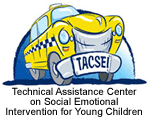

Implementing Effective Practices to Support Young Children’s Social Emotional, Language, and Early Literacy Development
A Collaboration between TACSEI and CELL
Promoting Social Emotional Development |
SHARED PRACTICE |
Promoting Language and Literacy |
| Level 2 - PROVIDING SUPPORTIVE ENVIRONMENTS | ||
| To strengthen the relationship with the child and model responsivity and reciprocity. |
2.1 Post daily schedules and routines with visual displays. |
To support children’s print awareness as well as provide an adaptation to the instruction during daily routines and transitions. |
| To provide a predictable routine, promote child understanding of expectations, and prepare children for changes that will occur in the regular schedule. |
2.2 Review schedule and refer to it throughout the day. |
By specifically pointing to the words and pictures in the daily schedule the child receives modeling of the function and purpose of print. |
| To provide the child with group learning experiences that provide opportunities for strengthening interactive skills, self-regulation, turn taking, and learn group behavior standards. |
2.3 Plan both large and small group activities throughout each day. |
To provide several opportunities for a child to practice literacy throughout the day. Practice and engagement lead to competence. |
| To promote the child’s appropriate engagement and interest in activities. When classrooms lack balance, child challenging behavior is more likely to occur. |
2.4 Include a balance of teacher-directed and child-directed activities. |
By following a child’s lead, the adult can determine the child’s interests and level of participation. The adult may then respond with teacher-directed activities that match the child accordingly. This will enhance the literacy learning opportunities. |
| Classrooms should be arranged so that children can independently move around and select activities and materials. Classroom arrangement should make it easy for adults to supervise and support children’s play and social interactions. |
2.5 Have a classroom arrangement that allows children to move easily in the classroom. |
Environmental adaptations that allow children to move easily within their classroom giving them access to early literacy materials. |
| To ensure that children who need additional support are able to be appropriately engaged, build relationships with peers, and experience success in the classroom. |
2.6 Provide support and special preparation for children who might need additional learning opportunities, adapted materials and activities, peer support, or more support to follow the routine, etc. |
To provide necessary adaptations so that a child can fully participate in all classroom literacy activities with peers. |
| Classroom centers should be designed with enough materials to support the appropriate and sustained play of the children within the center. Center boundaries should be clear so that children understand the expectations for the center and use of materials. |
2.7 Offer an adequate number and variety of centers to maintain children’s interest and support the number of children at each center (1 center for every 4 children). |
A literacy-rich classroom offers an adequate number of learning centers that contain a variety of literacy materials in order to maintain a child’s interests. It also contains a responsive adult that models the function of such literacy materials and activities. |
| Supporting the active engagement of children will prevent child problem behavior. |
2.8 Structure activities so children are actively engaged almost all of the time (i.e., actively participating). Change my activity when children lose interest. |
The more that children actively engage in a literacy activity the more competent they become in literacy practices which will eventually lead to mastery. |
| Transitions that are confusing, impose prolonged wait time for an activity, or are not conducted in an orderly manner can lead to child problem behavior. To support child appropriate behavior, children should anticipate the transition and understand the steps and expectations for transitions. |
2.9 Develop transition games, songs or other supports to ensure all children are actively engaged in the transition. Actively engage all children in the transition; even those who are waiting their turn. Provide individual prompts (verbal, visuals…) to children who might have difficulty transitioning. |
Embed early literacy activities during transition times in order to increase the opportunity for children to explore oral language and print, such as songs, storytelling, and books. |
| To promote children’s engagement in social interactions, learning activities and play. |
2.10 Provide frequent, intentional and situationally interesting learning opportunities that promote the participation and development of all children. |
Literacy learning opportunities must occur frequently and in a manner in which children are fully engaged in the activity. |
| Using the personal interests of children promotes their interest and engagement within activities and supports their expression of interest and identify. |
2.11 Use personal interest of individual children to create learning opportunities and activities. |
Using a child’s personal interests to create literacy learning opportunities increases child participation in the activity and child learning. |